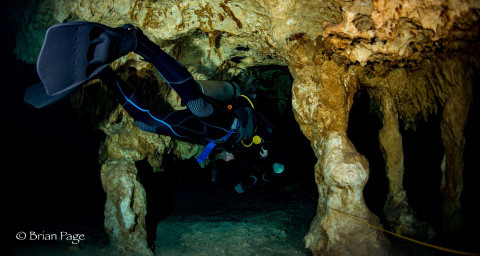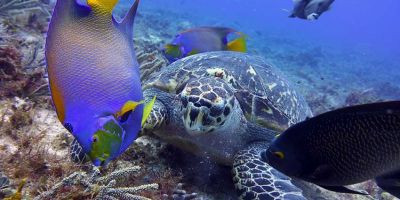The best cenotes to Scuba Dive in the Riviera Maya
All along the Riviera Maya jungle there exist many natural underground river and cave systems filled with crystal-clear water named hundreds of years ago by Mayans as cenotes. These Cenotes are considered by the Mayans to be a "window into the underworld"
Cenotes are places of great calm, most of them inside of the jungle, and diving into them is a beautiful and relaxing experience that changes the perspective of traditional scuba diving in the ocean.
Each Cenote has something different to offer, some are shallow, some deep, some freshwater, some a mixture of fresh and salt. Some even have hydrogen sulfide layers, some have very little natural light, others have many holes in the roof where shafts of light breakthrough.
Each one offers a new and unique diving experience.
Here in this article we'll break down all that you need to know about Cenote Diving in the Riviera Maya plus a list of all the cenotes we offer.
Can anyone dive in a Cenote?
The magical Mexican cenotes are open for all certified divers who have Open Water or higher level scuba diving certification. Unfortunately they are not available to those who hold Scuba Diver qualification.
However, Casa Cenote is open to everyone, even those doing Discover Scuba Diving experience as it is completely open with no covered area.
Respect and safety rules to follow when diving in a cenote
Mexican law states that the guide must be fully cave certified and also carry twin tanks, have special torch and spares as well as other special equipment such as extra-long hoses.
Also, the guide can only take a maximum of 4 divers on a tour, they must follow a set route and abide by all other cavern rules.
The Cenotes are not cave diving , the divers are always within a specified distance of the entrance or an area that has access to the surface. The guide must always follow the set route and this is done by means of following a permanently laid line. These lines are checked on a regular basis to ensure that no-one has changed them and to confirm that they are securely fixed in place. They are not there to hold onto or use as a way of moving along.
Guides must register annually with the cenote , showing their professional certifications , to ensure only correctly certified guides are leading tours.
What to expect inside of a Cenote?
The temperature is colder than the sea
The water temperature in the Cenotes varies between 25 and 26°C all year round and despite being so hot outside, the underground environment gives them a cooler temperature than the ocean which varies between 26 and 30°C, hence most divers will prefer to use a long wetsuit for the cenote dives to avoid feeling cold, whereas they can use a short wet suit in the warmer ocean dives.
Cenotes have dark areas!
With the exception of Casa Cenote, there are large areas within moany of the cenote dives that are dark, hence each diver is given a modern high-power dive torch so they can see all the wonderful sights along the way.
These are not necessary for Casa Cenote as it is totally open.
Underwater life!
Fish life in the cenotes is minimal in general but it is possible to see little fish such as Sailfin Molly , Cenote Molly , Cichlids , Cave Blind Fish and Tetra ; big fish such as the Catfish and other species like the Slider Turtle and the Blue Crab.
As always, Casa Cenote is the exception, and has more fish life than all other Cenotes in the area.
Natural architecture
Cenotes were formed millions of years ago, around the prehistoric Ice Age, and from there they have undergone many changes through the years. Giant stalagmites, stalactites, and columns have formed, giving us spectacular underwater environments that you can only experience in the most famous spots of the Riviera Maya : Yucatán , Cancún , Playa del Carmen , Akumal , Tulum and more!
The combination of their natural architecture and the light provided by the holes or torches make awesome views
Meaning to the Mayans
Mayans considered cenotes as sacred places, giving them many religious meanings … One of the most important ones is the entrance to Xibalba. The Mayan culture believes that cenotes are a connection between our world and the underworld.
As cenotes were their water supply, they believed that the rain gods lived in the cenotes, and many ritual objects have been found inside them such as clay figures and vases, and tributes like gold and jade stone.
Because of its ritual and mystic connotations, Mayans used to make sacrifices at cenotes too. Many bones have been found in the sediment there, confirming this fact.
Where to stay
We work with many resorts, villas and private condos around the Akumal area offering pickup service from and to your accommodations.
If you are looking for a place we highly recommend the TAO México Ocean Residences, luxury and comfort will perfectly complement your stay at Akumal.
Cenotes we work with
As we already said, along the Riviera Maya there are hundreds of cenotes, and we offer some of the most impressive to dive in! All are just a few minutes away from our Shop.
Chikin-Ha Cenote
Located approximately 9kms from our shop, Cenote Chikin Ha is the first cenote in a system that connects several cenotes through more than 10km of underwater passages.
During the dive, you will be making your way to the nearby Rainbow Cenote. Upon reaching a depth of about 10m, strange visual effects can be seen as saltwater and freshwater start to mix. Descend a couple of meters into the saltwater and experience a comfortable change in temperature as salt water is warmer than freshwater. There are 2 dives possibilities in Chikin Ha.
Cenote Angelita
The furthest Cenote we travel to is 40 kms away but is worth the journey for experienced divers. Little Angel is hidden away in the jungle and offers something totally different from the other Cenotes. No big rooms or passages, this is a deep opening, dropping to 60m(200ft).
The top 27m(90ft) is freshwater with crystal clear visibility and then below is saltwater, entering from the sea. The defining layer at 28/29m (92-95ft) is Hydrogen Sulfide, giving the appearance of having reached the bottom!
As you go down through this layer you will feel as if you are looking back up at the clouds! A truly strange experience this Cenote dive is for Advanced divers only!
Tajama-Ha Cenote
This cenote is situated just 5kms north of us. The cavern tour takes the diver from the entrance into a wide room underneath an air-filled bat cave. Here light enters through holes in the ceiling and penetrates the water like laser beams during the summer months.
Along the cavern floor you will find hundreds of stalactites lying in the sediment. Continuing the dive, you enter the Sugar Bowl, a second small cenote where you can see an amazing light show on sunny days.
Tajma-Ha is decorated with stalactites and stalagmites and plenty of hidden fossils can be spotted if you look for them.
Chac Mool Cenote
Just 15 kms north, Chac Mool is considered one of the most spectacular on the peninsula.
In many parts of the system sunlight pours in through small openings , many formed by tree roots, giving a truly awesome light display in the water. Several rooms are connected by short passages and as you dive you will see many small tree roots that have penetrated the soft rock in search of water.
Here also you can encounter a Halocline , where saltwater enters the system from the ocean and meets the freshwater creating this strange effect. Again Chac Mool offers 2 diving possibilities.
As Chac Mool is the first cenote south of Playa Del Carmen it can get very busy and at times the water clarity can be affected by the number of divers.
Cenote El Pit
Approximately 15kms south and within the Dos Ojos cenote system you find El Pit. Arrive early for a morning deep dive and the best light penetration.
Once in the water stop and appreciate the tranquil surrounding that tower above. Descend in the middle of the cenote through a shallow halocline towards the hydrogen sulfide cloud at 26 meters.
Like Angelita tree branches eerily protrude from the cloud in what seems to be the cavern floor. Continue your dive above the cloud exploring the cavernous overhang of the cenote before coming up to the sloping ceiling at 10 meters. Here you find stalactites of all shapes and sizes but also remember to look up and watch the laser beams of sunlight penetrating the entrance from above.
Dos Ojos
Just 10 minutes away from us by car, including a 2km drive into the jungle! Two huge open pools look up at you (Dos Ojos means Two Eyes).
These 2 large openings allow for spectacular light effects as divers approach them during their dives. Dos Ojos is now part of the largest underground river system in the world., (connecting several other local smaller Cenotes via smaller cave passages), but the main Cenote is made up of wide passages and chambers, c onsidered to be some of the biggest on the peninsula.
Dos Ojos allows for two separate dive routes, named Barbie Line and Bat Cave! Each dive is approximately 40-45 minutes with a maximum depth of just 12m (40ft).
Casa Cenote
20 minutes south of us we can visit Casa Cenote. Here in amongst the mangroves we can dive the generally crystal clear waters and see more fish life than all other cenotes. This is due to the fact that Casa Cenote is one of very few cenotes that is not in the jungle. Just 50 meters away from the entrance is the ocean and this is connected by an underground tube, allowing salt water and some salt water fish into the cenote. Here we can find Blue Armed crabs, small Tarpon as well as all the normal cenote fish such as Mollys.
What makes this easy and shallow dive (maximum just 6m/18ft) such a draw for divers is the chance to see "Pedro", the resident crocodile. (Don't worry he's only 1.8m/6ft nose to tail). Not something you'll encounter on many dives!!!.
Casa Cenote is also a great option for diving when the ocean conditions are not good, or for those who are looking for a very shallow easy dive.
If you're an experienced cenote diver and have done the above we have several other cenotes to choose from for something different!.
Alternately, you may want to consider moving further into the caverns by taking the " Intro to Cave Diving course", or even the Full Cave course with our highly experienced cave instructor.
Whatever your level is we have something to suit you.


























